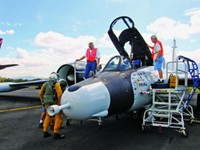Advertisement
Grab your lab coat. Let's get started
Welcome!
Welcome!
Create an account below to get 6 C&EN articles per month, receive newsletters and more - all free.
It seems this is your first time logging in online. Please enter the following information to continue.
As an ACS member you automatically get access to this site. All we need is few more details to create your reading experience.
Not you? Sign in with a different account.
Not you? Sign in with a different account.
ERROR 1
ERROR 1
ERROR 2
ERROR 2
ERROR 2
ERROR 2
ERROR 2
Password and Confirm password must match.
If you have an ACS member number, please enter it here so we can link this account to your membership. (optional)
ERROR 2
ACS values your privacy. By submitting your information, you are gaining access to C&EN and subscribing to our weekly newsletter. We use the information you provide to make your reading experience better, and we will never sell your data to third party members.
Physical Chemistry
Night-Shining Clouds
Studies of high-altitude clouds may illuminate atmospheric changes
by Jyllian Kemsley
December 17, 2007
| A version of this story appeared in
Volume 85, Issue 51
"Night shining," or noctilucent, clouds at Earth's poles are observable just after sunset or just before sunrise, when their high altitude allows them to reflect sunlight even when Earth's surface is dark. Scientists have observed that the clouds have been increasing in frequency and brightness over the past 27 years. Now, as part of NASA's Aeronomy of Ice in the Mesosphere (AIM) mission, a satellite is dedicated to observing these polar mesospheric clouds (PMCs). The observations are illuminating the mechanisms behind the clouds' formation, researchers said.

PMCs form at the polar caps during the summer seasons, at an altitude of 80 to 90 km. AIM has completed one season of observing PMCs at the North Pole and is now studying clouds at the South Pole. AIM researchers say the increase in frequency and brightness of the clouds may be due to increasing emissions of carbon dioxide and methane. For ice crystals to form and accumulate into clouds under the mesophere's extremely dry and low-pressure conditions, temperatures must be at or below -150 ºC. Carbon dioxide, contrary to its warming effect lower in the atmosphere, exerts a cooling effect in the upper atmosphere, and cooler temperatures lead to more ice crystal formation. Oxidation of methane to form water provides additional raw material for the crystals.
Using data from AIM, researchers have now identified long-predicted but never-observed charged ice particles, less than 10 nm in diameter, that exist at an altitude of 80 to 90 km. Those crystals grow in size, and when they reach about 20 nm, they start forming PMCs.
The clouds overall show more variability and structure than researchers had expected. The cloud behavior appears similar to what is observed as weather closer to Earth's surface, said Gary Thomas of the Laboratory for Atmospheric & Space Physics at the University of Colorado, Boulder, who spoke at the meeting.
The data also suggest that the polar site of cloud formation varies with temperature changes. A dip in mesospheric temperature of as little as 3 °C can cause a dramatic increase in cloud formation, noted Scott Bailey, a professor of electrical engineering at Virginia Polytechic Institute & State University, who also spoke at the meeting. "The clouds are an exquisite thermometer," Bailey said. "For this reason we think the clouds are an indicator for global change in the mesosphere."




Join the conversation
Contact the reporter
Submit a Letter to the Editor for publication
Engage with us on Twitter